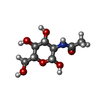+ Open data
Open data
- Basic information
Basic information
| Entry | Database: PDB / ID: 9hvi | |||||||||||||||||||||
|---|---|---|---|---|---|---|---|---|---|---|---|---|---|---|---|---|---|---|---|---|---|---|
| Title | PSMA in complex with nanobody 8 | |||||||||||||||||||||
 Components Components |
| |||||||||||||||||||||
 Keywords Keywords | MEMBRANE PROTEIN / carboxypeptidase complex nanobody | |||||||||||||||||||||
| Function / homology |  Function and homology information Function and homology informationAc-Asp-Glu binding / tetrahydrofolyl-poly(glutamate) polymer binding / glutamate carboxypeptidase II / folic acid-containing compound metabolic process / C-terminal protein deglutamylation / Aspartate and asparagine metabolism / dipeptidase activity / carboxypeptidase activity / metallocarboxypeptidase activity / peptidase activity ...Ac-Asp-Glu binding / tetrahydrofolyl-poly(glutamate) polymer binding / glutamate carboxypeptidase II / folic acid-containing compound metabolic process / C-terminal protein deglutamylation / Aspartate and asparagine metabolism / dipeptidase activity / carboxypeptidase activity / metallocarboxypeptidase activity / peptidase activity / cell surface / proteolysis / extracellular exosome / metal ion binding / membrane / plasma membrane / cytoplasm Similarity search - Function | |||||||||||||||||||||
| Biological species |  Homo sapiens (human) Homo sapiens (human) | |||||||||||||||||||||
| Method | ELECTRON MICROSCOPY / single particle reconstruction / cryo EM / Resolution: 2.46 Å | |||||||||||||||||||||
 Authors Authors | Alon, G. / Zalk, R. / Huynh, T.T. / Zalutsky, M.R. / Weizmann, Y. / Zarivach, R. / Papo, N. | |||||||||||||||||||||
| Funding support |  Israel, Israel,  United States, United States,  United Kingdom, 6items United Kingdom, 6items
| |||||||||||||||||||||
 Citation Citation |  Journal: Int J Biol Macromol / Year: 2025 Journal: Int J Biol Macromol / Year: 2025Title: Structural analysis of nanobody interactions with their prostate-specific membrane antigen binding epitopes. Authors: Gal Alon-Zchut / Ran Zalk / Truc T Huynh / Michael R Zalutsky / Yossi Weizmann / Raz Zarivach / Niv Papo /   Abstract: Prostate-specific membrane antigen (PSMA), overexpressed in prostate cancer, is a promising target for diagnostics and therapy. However, the monoclonal antibodies in current use for PSMA targeting ...Prostate-specific membrane antigen (PSMA), overexpressed in prostate cancer, is a promising target for diagnostics and therapy. However, the monoclonal antibodies in current use for PSMA targeting and inhibition have suboptimal activities due to their poor tissue and cell penetration and slow normal tissue clearance. Potentially superior alternatives are nanobodies (NBs), the single-chain variable domains of heavy-chain antibodies derived from camelids. The advantages of NBs include small size (~15 kDa), ability to bind hidden epitopes, and rapid clearance. In contrast to most known PSMA inhibitors, which bind to the same catalytic site in PMSA, NBs can bind to different PSMA epitopes, facilitating heterovalent binding strategies that could enhance their therapeutic and diagnostic potential. The objective of this study was to map these binding epitopes and hence to acquire an atomic-resolution understanding of NB-PMSA binding by investigating the structural interactions between PSMA and three NBs (NB7, NB8, and NB37). Using cryo-electron microscopy to generate high-resolution structures of NB-PSMA complexes, we found that NB7 had the highest affinity for PSMA due to a larger interface and to stabilizing interactions, including salt bridges and π-π stacking. Notably, we also found that NB7 and NB8 can bind simultaneously to different PSMA epitopes without interfering with the function of PSMA (which is still not completely known), opening the way for the development of theranostic applications for prostate cancer treatment and imaging. Importantly, NB7 binds specifically to human PSMA but not to murine PSMA, due to key amino acid differences responsible for its species specificity. | |||||||||||||||||||||
| History |
|
- Structure visualization
Structure visualization
| Structure viewer | Molecule:  Molmil Molmil Jmol/JSmol Jmol/JSmol |
|---|
- Downloads & links
Downloads & links
- Download
Download
| PDBx/mmCIF format |  9hvi.cif.gz 9hvi.cif.gz | 338.6 KB | Display |  PDBx/mmCIF format PDBx/mmCIF format |
|---|---|---|---|---|
| PDB format |  pdb9hvi.ent.gz pdb9hvi.ent.gz | 272.2 KB | Display |  PDB format PDB format |
| PDBx/mmJSON format |  9hvi.json.gz 9hvi.json.gz | Tree view |  PDBx/mmJSON format PDBx/mmJSON format | |
| Others |  Other downloads Other downloads |
-Validation report
| Summary document |  9hvi_validation.pdf.gz 9hvi_validation.pdf.gz | 1.8 MB | Display |  wwPDB validaton report wwPDB validaton report |
|---|---|---|---|---|
| Full document |  9hvi_full_validation.pdf.gz 9hvi_full_validation.pdf.gz | 1.8 MB | Display | |
| Data in XML |  9hvi_validation.xml.gz 9hvi_validation.xml.gz | 58 KB | Display | |
| Data in CIF |  9hvi_validation.cif.gz 9hvi_validation.cif.gz | 88.8 KB | Display | |
| Arichive directory |  https://data.pdbj.org/pub/pdb/validation_reports/hv/9hvi https://data.pdbj.org/pub/pdb/validation_reports/hv/9hvi ftp://data.pdbj.org/pub/pdb/validation_reports/hv/9hvi ftp://data.pdbj.org/pub/pdb/validation_reports/hv/9hvi | HTTPS FTP |
-Related structure data
| Related structure data |  52435MC  9hlwC  9hvkC  9hvlC M: map data used to model this data C: citing same article ( |
|---|---|
| Similar structure data | Similarity search - Function & homology  F&H Search F&H Search |
- Links
Links
- Assembly
Assembly
| Deposited unit | 
|
|---|---|
| 1 |
|
- Components
Components
-Protein , 2 types, 4 molecules AEHQ
| #1: Protein | Mass: 78341.352 Da / Num. of mol.: 2 / Fragment: UNP residues 56-750 Source method: isolated from a genetically manipulated source Source: (gene. exp.)  Homo sapiens (human) / Gene: FOLH1, FOLH, NAALAD1, PSM, PSMA, GIG27 / Production host: Homo sapiens (human) / Gene: FOLH1, FOLH, NAALAD1, PSM, PSMA, GIG27 / Production host:  #2: Protein | Mass: 13427.674 Da / Num. of mol.: 2 Source method: isolated from a genetically manipulated source Source: (gene. exp.)   |
|---|
-Sugars , 4 types, 14 molecules 
| #3: Polysaccharide | Source method: isolated from a genetically manipulated source #4: Polysaccharide | Source method: isolated from a genetically manipulated source #5: Polysaccharide | Source method: isolated from a genetically manipulated source #6: Sugar | ChemComp-NAG / |
|---|
-Non-polymers , 3 types, 7 molecules 




| #7: Chemical | ChemComp-ZN / #8: Chemical | #9: Chemical | ChemComp-CL / | |
|---|
-Details
| Has ligand of interest | Y |
|---|---|
| Has protein modification | Y |
-Experimental details
-Experiment
| Experiment | Method: ELECTRON MICROSCOPY |
|---|---|
| EM experiment | Aggregation state: PARTICLE / 3D reconstruction method: single particle reconstruction |
- Sample preparation
Sample preparation
| Component | Name: PSMA in complex with nanobody 8 / Type: COMPLEX / Entity ID: #1-#2 / Source: RECOMBINANT |
|---|---|
| Molecular weight | Value: 0.23 MDa / Experimental value: NO |
| Source (natural) | Organism:  |
| Source (recombinant) | Organism:  |
| Buffer solution | pH: 8 |
| Specimen | Embedding applied: NO / Shadowing applied: NO / Staining applied: NO / Vitrification applied: YES |
| Specimen support | Grid material: COPPER / Grid mesh size: 200 divisions/in. / Grid type: Quantifoil R1.2/1.3 |
| Vitrification | Instrument: HOMEMADE PLUNGER / Cryogen name: ETHANE / Details: manually blotted for 3 seconds |
- Electron microscopy imaging
Electron microscopy imaging
| Microscopy | Model: TFS GLACIOS |
|---|---|
| Electron gun | Electron source:  FIELD EMISSION GUN / Accelerating voltage: 200 kV / Illumination mode: FLOOD BEAM FIELD EMISSION GUN / Accelerating voltage: 200 kV / Illumination mode: FLOOD BEAM |
| Electron lens | Mode: BRIGHT FIELD / Nominal defocus max: 2000 nm / Nominal defocus min: 500 nm / Alignment procedure: COMA FREE |
| Image recording | Electron dose: 30 e/Å2 / Film or detector model: TFS FALCON 4i (4k x 4k) |
- Processing
Processing
| EM software |
| ||||||||||||||||||||||||
|---|---|---|---|---|---|---|---|---|---|---|---|---|---|---|---|---|---|---|---|---|---|---|---|---|---|
| CTF correction | Type: NONE | ||||||||||||||||||||||||
| 3D reconstruction | Resolution: 2.46 Å / Resolution method: FSC 0.143 CUT-OFF / Num. of particles: 2419108 / Algorithm: FOURIER SPACE / Symmetry type: POINT | ||||||||||||||||||||||||
| Refinement | Highest resolution: 2.46 Å Stereochemistry target values: REAL-SPACE (WEIGHTED MAP SUM AT ATOM CENTERS) | ||||||||||||||||||||||||
| Refine LS restraints |
|
 Movie
Movie Controller
Controller







 PDBj
PDBj




